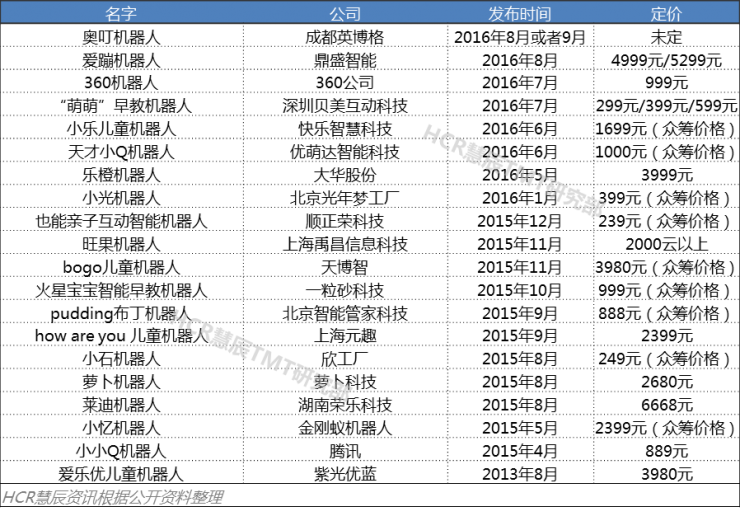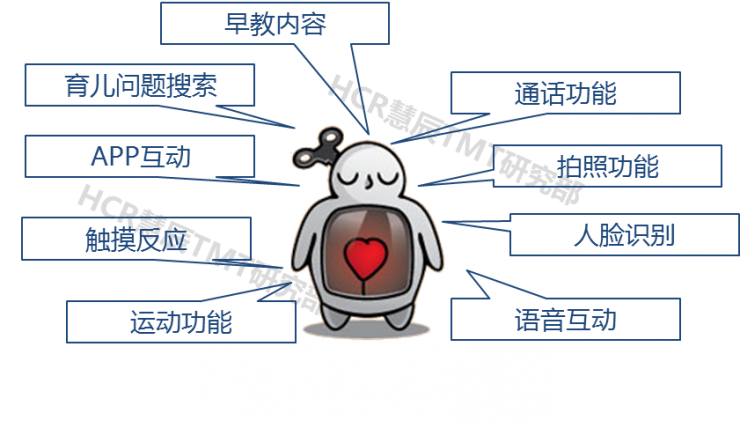Lei Feng network (search "Lei Feng network" public number concerned) : According to author Liu Yao, HCR Hui Chen Information TMT Research Department.
The spring and evening excellent selection certainly did make the robot fire. The robots in the book and in the movie have come to people's lives. Asimov’s three laws of robotics may have to go from the sci-fi world to the real world. In the past two years, domestic consumer robots have gradually come to people's attention, especially children's accompanying robots (hereinafter referred to as children's robots), and it seems that China's children's toys have finally been upgraded to a higher level. The HCR Huichen Information TMT Research Department compiled the children's robots with high network exposure rates in the past two years based on publicly available data. Since the beginning of 2015, children's robots have appeared one after another in the market, and after August 2015, the frequency of children's robotic products has gradually accelerated, including companies that have long been rooted in the field of children's robots, and leading companies in the field of security. The China Resources and Internet Company 360 company also joined the development of children's robot products. In terms of pricing, children's robots with simple functions need at least 200 yuan, while those with high prices can reach more than 5,000 yuan. It can be said that children's robots are the "nobility" of early childhood education products.

Such a nobleman, expensive is not justified?
As more and more companies enter the field of children's robots, the functions of children's robots are new and very rich in the past two years. The HCR Hui Chen Information TMT Research Department organized a child's robot features, as shown below: At present, children's robots rely on consumer-level artificial intelligence technology and the development of the Internet, with voice interaction, face recognition, App interconnection and Functional features, these are not children's products in the past. So, dare to "get your way first."

However, although there are so many companies that have produced so many products to enter the market and products have so many functions, there is no certain robot that has become the new darling of the general public. There are two main reasons:
1. Children's robots have little difference between products.
The first is the small difference in product features. As shown in the above diagram, although the product features of the current children's robot market are rich, each robot is a “standard†feature, and none of the robots have their own characteristics or are Functional breakthrough. Followed by children's technical intelligence technology, early childhood content has little difference. Consumer-level artificial intelligence technologies, such as face recognition and voice interaction, have become modular, and have matured at the current level of technology. However, the technology gap is still a fifty-step process. State; Finally, talk about the appearance of the image, the image in the above figure is the shape of some domestic children's robots compiled by HCR Huichen Information TMT Research Department based on public information. It looks very silly and unclear. The uniform white case has a round head, and the original child robot also has a school uniform.

2. In terms of content, there is little or no difference between children's robots and other early education products.
Although most children's robots use early childhood content as a selling point, early childhood content cooperates with some early education content producers and has little of their own characteristics and authority, including children's songs, nursery rhymes, cartoons, early childhood education software, and children and parents. Some of the content, the main hit is to entertain, let the children's robots participate in the child's growth, more importantly, let the tired parents can rest for a while, so that children can play with children's robots for a while. But after reading the contents of the early education of robots, the author could not help but ask questions. What is the difference between the contents of the children's robot and the game education software on the iPad? If you look at cartoons, there are iPads and TVs. The screens are large and the resolution is high. If you play games and have iPads, the richness of the content is much higher than that of children's robots. If you want to learn something, you can use advanced early childhood content such as Qiaohu. Product manufacturers have long gone deep into the hearts of parents. At the screen level, content richness and authority, and even interactivity, children's robots currently have a certain gap in their professional early education products. Will parents pay for this?
The upstart looks like a child robot that doesn’t have any meaning. How do you work hard and grow into a favorite product for parents and children? Here are two directions:
1, early education content and technology integration, product features and functional differences.
Children's robots have features that neither the iPad nor the TV have. Children often feel more interested in the activities of large limbs, and parents also hope that children can move, rather than blindly facing a screen. Only the current educational content of children's robots is not only simple sound and image stimulation when interacting with children, but also requires more hardware actions based on children's robots to interact with children more. At present, the educational content of children's robots and the robot itself are fragmented, and the robots will not react when the children interact with the educational content. In simple terms, for example, when a child corrects a question or a victory in the game, a child robot can have a cheer, a celebration, an encouragement, and a praise interaction in the body movement. This is the response that a child robot should behave as a robot, and early education The single interactive form of content is also improved by the robot's body movements. Even if this is the same function and content of early childhood education, it will have a completely different effect, so that products show differences.
2, Meng is justice, mature IP image to help children's robot to change the image recognition.
As mentioned earlier, the appearance of children's robots is poorly recognizable, making them difficult to remember and cannot be used as selling points. Compared with the upgrading of technology and content essence, changing the appearance of hardware to increase one's own differences will be an easier choice for children's robotics companies. Will children's robot manufacturers later use their own designs or use "acquisitionism" to use the existing IP image? We believe there is a high possibility of directly using the existing animation/game/book IP image.
There are two reasons:
First, the use of robots to test the original IP image of the water, the cost is too high, will increase the hardware R & D costs, in the country more and more children's robot products, more and more competition, this strategy is too risky.
Second, domestic books and animations have accumulated IP images that can be used. Whether we like it or not, Pleasant Goat and Big Big Wolf, Bear Big Bear 2 will indeed be more recognizable and more attractive to children. Moreover, many classic images have not been well developed. The IPs of many domestic images such as the famous fairy tale king Mr. Zheng Yuanjie’s Pipiru and Roussi’s, Shuk and Beta, and the mythology’s Qitian Dasheng’s Sun Wukong, etc. It is well developed. Therefore, a suitable IP image is likely to help a child's robot become a detonation. In January this year, Aofei Animation invested 50 million yuan in Turing robots and obtained a corresponding 5% stake. Both of them also announced high-profile announcements in the children's robot industry recently, and will develop some of the current animated images. It can be foreseen that more children's robot companies will consider jointly developing products with IP image-owning companies in the future, or adopting paid methods to purchase mature IP image production products.
[Author] HCR Hui Chen Information TMT Research Department is a senior market research team, long-term concern about the Internet, mobile Internet, Internet of things and "smart +" field. Interested may pay attention to its WeChat public number: Intelligent Institute.